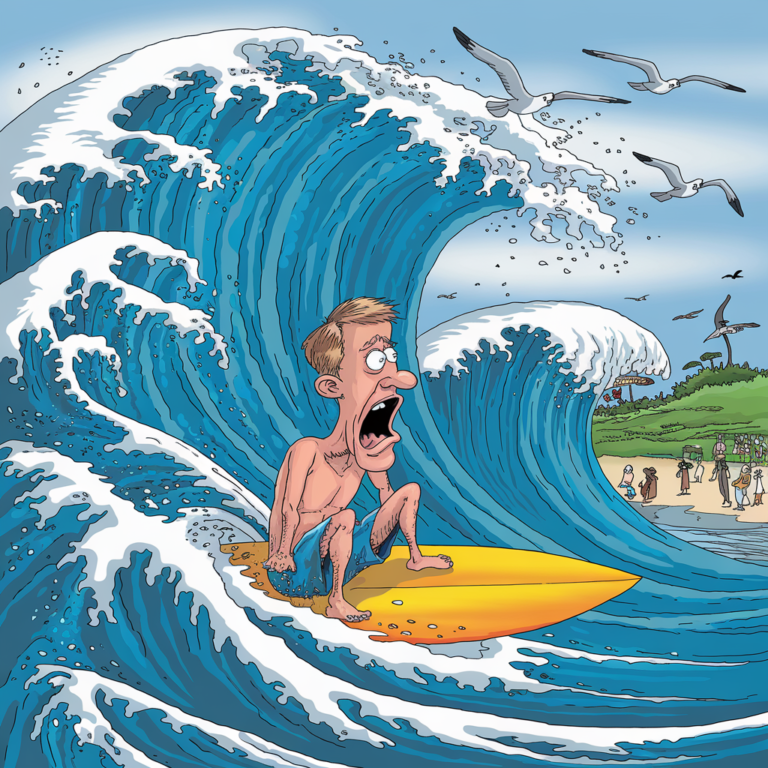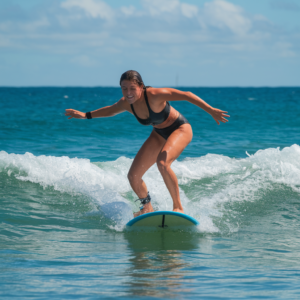Surfing—it’s the ultimate dance with nature, riding the mighty waves with grace and finesse. But behind the picturesque scenes of surfers carving through the ocean lies a challenging and demanding sport. For the uninitiated, the question “Is surfing hard?” often comes up. The short answer is yes, surfing is hard, and here’s why. From balancing on a moving board to reading the ever-changing ocean, surfing requires a unique blend of skills, strength, and intuition. Let’s dive into the eleven reasons that make surfing one of the most challenging yet rewarding sports out there.
Overview
So, you’ve seen those epic surf videos and thought, “How hard can it be to ride a wave?” Well, let’s get real about the gnarly truth of surfing. It’s not just about hopping on a board and catching a wave; it’s a full-body workout and a mental challenge all rolled into one salty adventure. Here’s a breakdown of why surfing isn’t just a walk on the beach.
- Balance on a Moving Platform: Imagine trying to stand on a balance board that’s constantly shifting beneath your feet. That’s surfing for you. The ocean is an unpredictable beast, and maintaining your balance on a surfboard requires serious core strength and stability.
- Paddling Power: Before you even think about riding a wave, you need to paddle out past the breaking waves. This isn’t a leisurely swim; it’s an intense upper-body workout. Your arms, shoulders, and back muscles will burn as you fight against the waves, and if you’re not in top shape, you’ll tire out quickly.
- Wave Reading: Surfers are like ocean whisperers. They need to read the waves, understand the swell, and anticipate where and when the wave will break. This takes time, practice, and a deep understanding of the ocean’s rhythms.
- Timing and Positioning: Catching a wave is all about timing and positioning. You need to be in the right spot at the right time, and then you have to pop up on your board with precision. Too early or too late, and you’ll miss the wave. It’s a split-second decision that requires quick reflexes and experience.
- Pop-Up Technique: It sounds simple, but executing it smoothly and quickly while the wave is propelling you forward is a major challenge.
- Fear Factor: The ocean is powerful and sometimes scary. Fear of wiping out, hitting the reef, or encountering marine life can mess with your focus. Overcoming this fear and staying calm under pressure is crucial.
- Stamina and Endurance: Surfing sessions can last for hours. You need to have the stamina to paddle, catch waves, and recover from wipeouts over and over again. It’s a test of endurance that goes beyond physical fitness.
- Board Control: Each surfboard has its own quirks, and mastering your board is essential. From shortboards to longboards, each type requires a different approach and handling. Learning how to maneuver and control your board in various conditions is a skill that takes time to develop.
- Environmental Conditions: Surfers need to adapt to different water conditions, from choppy seas to smooth swells. Wind, tide, and weather all affect the surf, and being able to handle these variations is part of the challenge.
- Mental Toughness: Surfing isn’t just a physical battle; it’s a mental one too. You’ll spend a lot of time waiting for the right wave, dealing with frustration, and pushing through tough sessions.
- Learning Curve: It can take years to become proficient. The progress might be slow, and there will be many wipeouts and setbacks along the way. But each wave ridden, no matter how small, is a victory.
Choosing the Right Gear
Now that we’ve established that surfing is no cakewalk, let’s talk about one of the most crucial elements of your surfing journey: the gear. Having the right equipment can make a world of difference in your surfing experience. From surfboards to wetsuits, choosing the right gear tailored to your needs and skill level is essential. Here’s a comprehensive guide to help you navigate the world of surf gear, complete with a comparison table of popular surfboards for beginners and where to buy them.
Surfboards: Finding the Right Fit
As a beginner, you’ll want a board that offers stability and ease of paddling. Let’s compare some of the popular surfboards suitable for novices.
| Surfboard Model | Length | Width | Volume | Best For | Price Range | Where to Buy |
| Soft Top Longboard | 8′ – 9′ | 22″ – 23″ | 60 – 80 L | Stability | $200 – $400 | Local surf shops, Amazon, Costco |
| Mini Mal | 7’6″ – 8′ | 21″ – 22″ | 55 – 70 L | Maneuverability | $300 – $500 | Online retailers, local surf shops |
| Funboard | 7′ – 8′ | 21″ – 22″ | 50 – 60 L | All-around surfing | $300 – $600 | Online surf stores, specialty shops |
| Fish Surfboard | 5’6″ – 6’6″ | 20″ – 22″ | 35 – 50 L | Small waves | $400 – $700 | Surfboard shapers, online surf shops |
| Hybrid Board | 6′ – 7′ | 21″ – 22″ | 40 – 55 L | Versatility | $350 – $650 | Local surf shops, online retailers |
Soft Top Longboard: The quintessential beginner’s board, soft top longboards are forgiving and provide ample stability. Their buoyancy makes paddling easier, and their length offers a smooth, stable ride.
Mini Mal: A great option for those looking to transition from a longboard, minimals offer a balance between stability and maneuverability.
Funboard: Aptly named, funboards are designed to provide an enjoyable surfing experience. They’re a bit shorter than longboards but still offer good stability, making them ideal for learning to turn and carve.
Fish Surfboard: Known for their wide, swallowtail design, fish boards excel in small to medium waves. They’re great for beginners who want to start experimenting with more dynamic surfing.
Hybrid Board: Combining elements of different board types, hybrids offer versatility. They’re suitable for various conditions and allow beginners to explore different surfing styles.
Wetsuits: Staying Warm and Protected
Depending on where you surf, a wetsuit might be a necessity. Wetsuits provide insulation and protect your skin from the elements. Here are some options for different water temperatures:
| Wetsuit Type | Thickness | Water Temperature | Best For | Price Range | Where to Buy |
| Spring Suit | 2mm | 68°F – 77°F | Mild conditions | $70 – $150 | Online retailers, local surf shops |
| Full Suit | 3/2mm | 60°F – 68°F | Moderate conditions | $150 – $300 | Online surf stores, sporting goods stores |
| Full Suit | 4/3mm | 50°F – 60°F | Cooler conditions | $200 – $400 | Surf specialty stores, online retailers |
| Hooded Full Suit | 5/4mm | 45°F – 55°F | Cold conditions | $300 – $500 | Specialty surf shops, online retailers |
Spring Suit: Ideal for warm waters, spring suits are short-sleeved and provide light insulation. They’re perfect for summer surfing or tropical destinations.
Full Suit (3/2mm): This is the go-to wetsuit for moderate water temperatures.
Full Suit (4/3mm): For those surfing in cooler waters, a thicker full suit is necessary. It provides more insulation to keep you comfortable during longer sessions in the water.
Hooded Full Suit (5/4mm): When surfing in frigid conditions, a hooded full suit is essential. It provides maximum warmth and protection, allowing you to surf even in the chilliest waters.
Where to Buy
Finding the right gear can be as important as choosing the right waves. Here are some recommended places to buy surf gear:
- Local Surf Shops: Supporting local businesses often means getting personalized advice and service. Surf shop staff are usually surfers themselves and can provide valuable insights.
- Online Retailers: Websites like Amazon, Surf Station, and Wetsuit Wearhouse offer a wide range of options and often have customer reviews to help you make an informed decision.
- Specialty Stores: For more specialized gear, surf specialty stores like Rip Curl, O’Neill, and Billabong have a broad selection and expert staff to assist you.
Tips for Overcoming Surfing Challenges
Surfing is undeniably tough, but that doesn’t mean it’s impossible to conquer. With the right mindset, dedication, and a few handy tips, you can navigate through the challenges and enjoy the stoke of riding waves. Here are some practical tips to help you overcome the hurdles of surfing:
Start with the Right Instruction
Investing in proper surf lessons can make a huge difference. A good instructor can teach you the fundamentals, from paddling techniques to reading waves. They’ll help you avoid common beginner mistakes and provide personalized feedback to improve your skills. Local surf schools and experienced instructors are invaluable resources for anyone starting out.
Practice Your Pop-Up
The pop-up move is crucial for catching waves and maintaining balance. Practicing this maneuver on land can significantly improve your muscle memory and execution. Lay on your board, simulate paddling, and then quickly spring to your feet. Repeating this drill will help you develop the necessary speed and coordination for a successful pop-up.
Build Your Fitness
Activities like swimming, yoga, and Pilates can enhance your paddling power, balance, and overall stamina, making you more prepared to tackle the waves.
Choose the Right Conditions
Starting in smaller, gentler waves can boost your confidence and help you master the basics without getting overwhelmed. Check local surf reports and aim for days when the swell is manageable and the weather conditions are favorable. As you progress, gradually challenge yourself with bigger and more powerful waves.
Stay Calm and Positive
It’s easy to get frustrated with wipeouts and slow progress, but maintaining a positive attitude is key. Celebrate small victories, stay patient, and remind yourself that every surfer started as a beginner.
Learn from Your Mistakes
Every wipeout and missed wave is an opportunity to learn. Pay attention to what went wrong and how you can improve. Whether it’s adjusting your stance, timing your pop-up better, or choosing a different wave, analyzing your mistakes helps you grow as a surfer. Don’t be afraid to ask more experienced surfers for tips and advice.
Respect the Ocean
Understanding and respecting the ocean is fundamental to becoming a good surfer. Learn about tides, currents, and wave formations. Always be aware of your surroundings and never underestimate the power of the sea. Safety should always be your top priority, so know your limits and don’t take unnecessary risks.
Connect with the Surfing Community
Joining a local surf club or group can provide support, camaraderie, and valuable insights. Experienced surfers can offer guidance, share their experiences, and help you navigate the challenges of the sport. Plus, surfing with others can make the learning process more enjoyable and motivating.
FAQs
How long does it take to learn to surf?
Some might get the hang of it in a few weeks, while others may take several months to feel comfortable on a board. Factors such as physical fitness, frequency of practice, and previous experience with other board sports can influence your learning curve. Remember, the key is consistency and patience. Regular practice and gradual progression are essential.
What is the best surfboard for beginners?
For beginners, a soft top longboard is often the best choice. These boards are longer, wider, and more buoyant, providing excellent stability and ease of paddling. They make it easier to catch waves and maintain balance, which is crucial for learning the basics. As you advance, you might transition to a mini mal or funboard to start experimenting with more maneuverable boards.
Do I need to be a strong swimmer to surf?
Yes, being a strong swimmer is important for surfing. Paddling out to the waves requires significant upper body strength and endurance. Additionally, being comfortable in the water is crucial for your safety, as you need to be able to handle wipeouts and swim back to your board or shore if necessary. Improving your swimming skills will enhance your surfing experience and ensure you can manage the ocean’s challenges.
What should I wear when surfing?
The appropriate surfing attire depends on the water temperature. In warm climates, a rash guard and board shorts might suffice to protect your skin from the sun and surfboard wax. In cooler waters, a wetsuit is essential to keep you warm and comfortable. Wetsuits come in different thicknesses, typically ranging from 2mm for mild conditions to 5/4mm for cold waters. Always choose a suit that provides the right balance of warmth and flexibility for the conditions you’ll be surfing in.
How do I know which waves to catch?
Wave selection is a skill that improves with experience. As a beginner, look for smaller, rolling waves that break gently. These are often found in beach breaks with sandy bottoms, making them more forgiving. Avoid large, steep, or fast-breaking waves until you have more confidence and skill. Observing more experienced surfers and taking note of where and when they catch waves can also be a valuable learning tool.
What are some common mistakes beginners make?
Some common mistakes include:
- Poor Board Positioning: Lying too far back or forward on the board can hinder your paddling and stability.
- Inadequate Paddling: Not paddling hard enough to catch the wave can result in missing it.
- Rushing the Pop-Up: Trying to stand up too quickly without proper balance can lead to wipeouts.
- Ignoring Surf Etiquette: Failing to follow basic surf etiquette, like not dropping in on someone else’s wave, can cause conflicts and accidents.
- Lack of Fitness: Underestimating the physical demands of surfing and not maintaining proper fitness can lead to fatigue and reduced performance.
How can I overcome the fear of wiping out?
Fear of wiping out is common, especially for beginners. To overcome it, start by practicing in smaller, less intimidating waves. Understand that falling is part of the learning process and that even experienced surfers wipe out. Focus on your breathing, stay calm, and remember that the more you practice, the more confident you’ll become.
Can I surf in any weather conditions?
While it’s possible to surf in various weather conditions, some are more favorable than others. Ideal surfing conditions typically include light offshore winds, a clean swell, and clear skies. However, surfing in stormy weather, with strong onshore winds or during heavy rain, can be dangerous due to poor visibility, strong currents, and unpredictable waves.
How important is surf etiquette?
Surf etiquette is crucial for maintaining a safe and respectful environment in the water. Basic rules include:
- Don’t Drop In: Never take off on a wave when someone else is already riding it.
- Paddle Wide: When paddling out, avoid the path of surfers riding the waves.
- Respect the Lineup: Take turns and respect the priority of those who have been waiting longer.
- Communicate: If you’re unsure about who has the right of way, communicate with other surfers to avoid collisions.
Conclusion
So, is surfing hard? The answer is a resounding yes, but that’s what makes it such an exhilarating and rewarding pursuit. Surfing is a unique blend of physical prowess, mental fortitude, and an intimate connection with the ever-changing ocean.
But the beauty of surfing lies in these very challenges. Each wave you catch, each moment you spend on the water, is a step forward in your surfing journey. The stoke of riding a wave, the sense of accomplishment after a tough session, and the camaraderie within the surfing community make all the hard work worthwhile. The ocean becomes your playground, and with each ride, you become more attuned to its rhythms and nuances.
Remember, every surfer started as a beginner, facing the same hurdles and frustrations. The key is persistence, patience, and a positive mindset. Embrace the learning process, celebrate your progress, and don’t be afraid to wipe out—it’s all part of the adventure. Equip yourself with the right gear, seek guidance from experienced surfers, and most importantly, enjoy the ride.
In the end, surfing is more than just a sport; it’s a way of life. It teaches you resilience, humility, and a deep appreciation for nature. So, whether you’re catching your first wave or working on advanced maneuvers, keep the stoke alive and ride on. Surf’s up!
If you found that interesting, you might also like the following articles:
How To Stand Up on a Surfboard: 10 Common Mistakes




